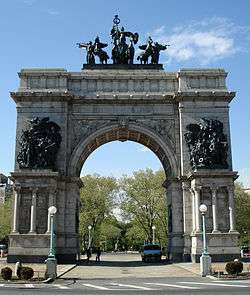Soldiers' and Sailors' Arch
| Soldiers' and Sailors' Arch | |
|---|---|
| Soldiers' and Sailors' Monument | |
|
The triumphal arch at the south end of the traffic oval (foreground). To the left and right of the memorial are additional streets (not shown). | |
| Type | American Civil War memorial |
| Location |
Grand Army Plaza Brooklyn, New York City, U.S. |
| Coordinates | 40°40′23″N 73°58′11″W / 40.672998°N 73.969842°WCoordinates: 40°40′23″N 73°58′11″W / 40.672998°N 73.969842°W |
| Elevation | 135 feet (41 m) |
| Height | 80 feet (24 m) |
| Dedicated | October 21, 1892 |
| Built | 1889-1892 |
| Built for | "To the Defenders of the Union, 1861-1865" |
| Rebuilt | 1898 (statues added) |
| Restored | 1976 |
| Architect | John H. Duncan |
| Sculptor |
Frederick Law Olmsted Calvert Vaux |
| Owner | City of New York |
| Website |
www |
| Designated | October 16, 1973 |
| Reference no. | LP-0821[1] |
 Soldiers' and Sailors' Arch location in Brooklyn | |
The Soldiers' and Sailors' Arch at the Grand Army Plaza in Brooklyn, New York City, is a triumphal arch dedicated "To the Defenders of the Union, 1861-1865".[2] The eastern end with a stairway to the observation deck and crowning sculpture is open to the public, while the remainder of the interior is sometimes opened for art shows and performances.
History


On August 6, 1889, William R. Ware and Charles B. Atwood, who had been appointed by the Soldiers' and Sailors' Monument Commission, selected John H. Duncan's design for the arch from 36 designs submitted the previous year.[3]
Frederick Law Olmsted and Calvert Vaux, in collaboration with architect Stanford White, built the arch after two-and-a-half months of site preparation; William Tecumseh Sherman was the speaker at the 1889 cornerstone, and President Grover Cleveland led the 1892 unveiling.[4]:tbd
The McKim, Mead and White firm recommended the bronze statues for the City Beautiful movement, and Park Commissioner Frank Squire engaged Frederick MacMonnies in 1894 to design the three bronze sculptural groupings. The interior arch faces have equestrian bas-reliefs of Abraham Lincoln and Ulysses S. Grant sculpted by William Rudolf O'Donovan (men) and Thomas Eakins (horses), that were added in 1895.[4]:723 Also added in 1895 by sculptor Frederick MacMonnies[5] are the Army and Navy sculptures and the allegorical crowning sculpture. This sculpture depicts the winged goddess of victory, following victorious combat (the Civil War) with instruments of war: sword, colors, flagstaff, and quadriga (the Union Army). Winged attendants are seen removing two of the four quadriga horses for peacetime use (postbellum recovery) while trumpeting the victory and freedom (Emancipation).
The arch was designated a landmark in 1973,[6] and the crowning sculpture was restored after the chariot's figure fell out in 1976.
See also
References
- ↑ "Soldiers' and Sailors' Memorial Arch, October 1973" (PDF). Neighborhood Preservation Center. Landmarks Preservation Commission. Retrieved 21 March 2016.
- ↑ Miller, Richard E (November 13, 2008). "Defenders of the Union" (HMdb.org webpage, marker 13548). Retrieved 2011-08-01.
- ↑ The three-person Commission consisted of Brooklyn Mayor Alfred C. Chapin, Aldermanic President McCarty, and Grand Army of the Republic Memorial Committee Chairman James D. Bell"Lucky Man: A New Yorker Gets the Soldier's Monument Work". The Brooklyn Daily Eagle. Brooklyn Daily Eagle. 1889-08-06. pp. Page 4, Column 2. Retrieved 2007-01-09.
- 1 2 White, Norval; Willensky, Elliot (2000). AIA Guide to New York City (4th ed.). New York Chapter, American Institute of Architects; Crown Publishers/Random House. ISBN 0-8129-3106-8.
Inside the arch itself is more subtle work, bas-reliefs of Lincoln (Thomas Eakins) and Grant (William O' Donovan), both installed in 1895.
:668 - ↑ (December 4, 1898). "Quadriga in its Place" The Brooklyn Daily Eagle Page 31
- ↑
| Wikimedia Commons has media related to Soldiers' and Sailors' Arch. |
